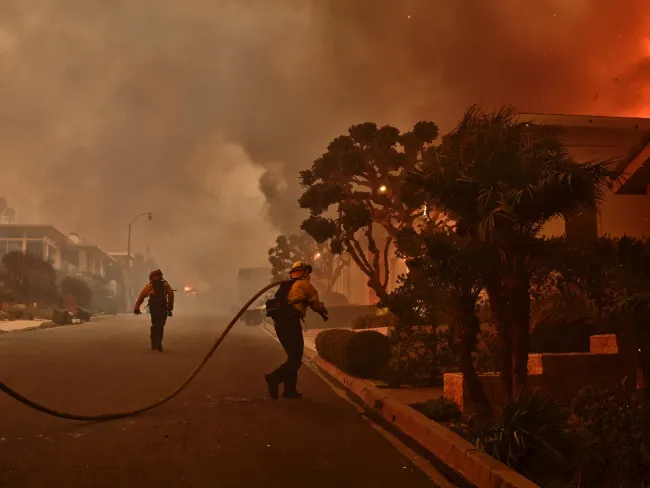Southern California is Engulfed in Flames: What You Need to Know About the Raging Infernos
Southern California is under siege as wildfires, fueled by some of the strongest winds in over a decade, ravage the region. Thousands have been forced to evacuate, and the skies are choked with smoke, creating a grim scene of destruction. These fires are not just destructive—they are relentless, growing by the hour, and far from being contained.
The Chaos Unfolding
On Tuesday, over 30,000 people in the Los Angeles area were forced to evacuate as flames consumed homes, trees, and power lines. The fierce Santa Ana winds, gusting up to 100 mph, have turned the fires into uncontrollable infernos. Two major blazes—the Palisades Fire in Pacific Palisades and the Eaton Fire near Pasadena—are wreaking havoc, with winds expected to intensify overnight. What we are witnessing is no longer just a firestorm; it’s an unfolding catastrophe.
Where the Flames Are Spreading
The fires are spreading rapidly, encircling Los Angeles like a deadly grip:
- Pacific Palisades: The Palisades Fire has scorched over 2,900 acres, doubling in size in just three hours. Over 10,000 homes and 13,000 structures are at risk in this upscale coastal neighborhood. Celebrities like James Woods and Mark Hamill have shared alarming footage of the flames encroaching on their properties.
- Eaton Canyon: The Eaton Fire, which erupted near Pasadena, has consumed 400 acres in a matter of hours. At least 550 homes are at risk, and a senior living facility had to evacuate as the fire approached, forcing elderly residents in wheelchairs and hospital beds to flee for their lives.
- Sylmar: The Hurst Fire has grown to 100 acres, forcing evacuations in this San Fernando Valley suburb. Roads are blocked with abandoned cars, making it nearly impossible for residents to escape, while bulldozers clear paths for emergency vehicles.
The Scale of Loss
The full extent of the damage is still being assessed, but it’s already clear that the destruction is catastrophic. Governor Gavin Newsom confirmed “many structures have already been destroyed” during his visit to the affected areas. The Palisades Fire alone has reduced entire neighborhoods to rubble, with homes consumed by flames and only ash remaining. Firefighters are doing all they can to protect what’s left, but the toll will continue to rise as the fires spread.
Why Is This Happening Now?
This disaster is the result of a perfect storm of conditions:
- Extreme Winds: The Santa Ana winds, reaching up to 100 mph, are fanning the flames and making containment nearly impossible. These winds are the strongest Southern California has seen in over a decade.
- Drought Conditions: The region has seen less than 0.1 inches of rain since early May, leaving the landscape bone-dry and highly combustible. The area is a tinderbox, just waiting for the right spark to ignite it.
- Climate Factors: The combination of dry air, high temperatures, and strong winds has created a “life-threatening” fire weather event, similar to the conditions that fueled the 2018 Camp Fire, California’s deadliest wildfire.
What’s Next?
The situation is expected to worsen before it improves:
- Winds to Intensify Overnight: The strongest winds are forecast to hit between 10 p.m. Tuesday and 5 a.m. Wednesday, with gusts potentially exceeding 100 mph. This will likely cause the fires to spread even faster and more unpredictably.
- Firefighters Grounded: Aircraft have been grounded due to the extreme winds, leaving firefighters to battle the blazes from the ground. Off-duty firefighters have been called in to help, but resources are already stretched thin.
- Evacuations and Power Outages: Over 220,000 people in Los Angeles County are without power, and evacuation orders are expanding. Residents are urged to stay alert and be ready to flee at a moment’s notice.
A Call to Action
Southern California is burning, and the worst may still be ahead. Officials are urging residents to follow evacuation orders, avoid unnecessary travel, and prepare for the possibility of new fires breaking out. The region is facing one of the most severe wildfire events in recent memory, and the battle to contain these infernos is far from over.
Stay safe, stay informed, and prepare for the worst. This is a disaster that demands vigilance and resilience from everyone in its path. The flames are closing in, and only swift action will ensure safety.
